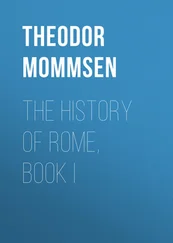Theodor Mommsen - The History of Rome. Book III
Здесь есть возможность читать онлайн «Theodor Mommsen - The History of Rome. Book III» весь текст электронной книги совершенно бесплатно (целиком полную версию без сокращений). В некоторых случаях можно слушать аудио, скачать через торрент в формате fb2 и присутствует краткое содержание. Жанр: История, Культурология, на английском языке. Описание произведения, (предисловие) а так же отзывы посетителей доступны на портале библиотеки ЛибКат.
- Название:The History of Rome. Book III
- Автор:
- Жанр:
- Год:неизвестен
- ISBN:нет данных
- Рейтинг книги:5 / 5. Голосов: 1
-
Избранное:Добавить в избранное
- Отзывы:
-
Ваша оценка:
- 100
- 1
- 2
- 3
- 4
- 5
The History of Rome. Book III: краткое содержание, описание и аннотация
Предлагаем к чтению аннотацию, описание, краткое содержание или предисловие (зависит от того, что написал сам автор книги «The History of Rome. Book III»). Если вы не нашли необходимую информацию о книге — напишите в комментариях, мы постараемся отыскать её.
The History of Rome. Book III — читать онлайн бесплатно полную книгу (весь текст) целиком
Ниже представлен текст книги, разбитый по страницам. Система сохранения места последней прочитанной страницы, позволяет с удобством читать онлайн бесплатно книгу «The History of Rome. Book III», без необходимости каждый раз заново искать на чём Вы остановились. Поставьте закладку, и сможете в любой момент перейти на страницу, на которой закончили чтение.
Интервал:
Закладка:
13.II. III. Increasing Powers of the Burgesses.
14.II. VIII. Officers.
15.II. III. Restrictions As to the Accumulation and Reoccupation of Offices.
16.II. III. New Opposition.
17.The stability of the Roman nobility may be clearly traced, more especially in the case of the patrician gentes , by means of the consular and aedilician Fasti. As is well known, the consulate was held by one patrician and one plebeian in each year from 388 to 581 (with the exception of the years 399, 400, 401, 403, 405, 409, 411, in which both consuls were patricians). Moreover, the colleges of curule aediles were composed exclusively of patricians in the odd years of the Varronian reckoning, at least down to the close of the sixth century, and they are known for the sixteen years 541, 545, 547, 549, 551, 553, 555, 557, 561, 565, 567, 575, 585, 589, 591, 593. These patrician consuls and aediles are, as respects their gentes , distributed as follows:
| Consuls (388-500) | Consuls (501-581) | Curule aediles of those 16 patrician colleges | |
|---|---|---|---|
| Cornelii | 15 | 15 | 15 |
| Valerii | 10 | 8 | 4 |
| Claudii | 4 | 8 | 2 |
| Aemilii | 9 | 6 | 2 |
| Fabii | 6 | 6 | 1 |
| Manlii | 4 | 6 | 1 |
| Postumii | 2 | 6 | 2 |
| Servilii | 3 | 4 | 2 |
| Quinctii | 2 | 3 | 1 |
| Furii | 2 | 3 | - |
| Sulpicii | 6 | 4 | 2 |
| Veturii | - | 2 | - |
| Papirii | 3 | 1 | - |
| Nautii | 2 | - | - |
| Julii | 1 | - | 1 |
| Foslii | 1 | - | - |
| 70 | 70 | 32 |
Thus the fifteen or sixteen houses of the high nobility, that were powerful in the state at the time of the Licinian laws, maintained their ground without material change in their relative numbers - which no doubt were partly kept up by adoption - for the next two centuries, and indeed down to the end of the republic. To the circle of the plebeian nobility new gentes doubtless were from time to time added; but the old plebian houses, such as the Licinii, Fulvii, Atilii, Domitii, Marcii, Junii, predominate very decidedly in the Fasti throughout three centuries.
18.I. V. The Senate.
19.III. IX. Death of Scipio.
20.III. X. Their Lax and Unsuccessful Management of the War f.
21.III. VI. In Italy.
22.III. VI. Conquest of Sicily.
23.The expenses of these were, however, probably thrown in great part on the adjoining inhabitants. The old system of making requisitions of task-work was not abolished: it must not unfrequently have happened that the slaves of the landholders were called away to be employed in the construction of roads. (Cato, de R. R. 2 )
24.III. VI. Pressure of the War.
25.III. VI. In Italy.
26.III. VII. Celtic Wars.
27.III. VI In Italy.
28.III. VII. Latins.
29.II. VII. Non-Latin Allied Communities.
30.III. VII. Latins.
31.Thus, as is well known, Ennius of Rudiae received burgess-rights from one of the triumvirs, Q. Fulvius Nobilior, on occasion of the founding of the burgess-colonies of Potentia and Pisaurum (Cic. Brut. 20, 79); whereupon, according to the well-known custom, he adopted the -praenomen- of the latter. The non-burgesses who were sent to share in the foundation of a burgess-colony, did not, at least in tin's epoch, thereby acquire de jure Roman citizenship, although they frequently usurped it (Liv. xxxiv. 42); but the magistrates charged with the founding of a colony were empowered, by a clause in the decree of the people relative to each case, to confer burgess-rights on a limited number of persons (Cic. pro Balb. 21, 48).
32.III. VII. Administration of Spain.
33.III. IX. Expedition against the Celts in Asia Minor.
34.III. X. Their Lax and Unsuccessful Management of the War f.
35.II. I. Term of Office.
36.III. VII. Administration of Spain.
37.III. XI. Italian Subjects, Roman Franchise More Difficult of Acquisition.
38.III. XI. Roman Franchise More Difficult of Acquisition.
39.In Cato's treatise on husbandry, which, as is well known, primarily relates to an estate in the district of Venafrum, the judicial discussion of such processes as might arise is referred to Rome only as respects one definite case; namely, that in which the landlord leases the winter pasture to the owner of a flock of sheep, and thus has to deal with a lessee who, as a rule, is not domiciled in the district (c. 149). It may be inferred from this, that in ordinary cases, where the contract was with a person domiciled in the district, such processes as might spring out of it were even in Cato's time decided not at Rome, but before the local judges.
40.II. VII. The Full Roman Franchise.
41.II. VII. Subject Communities.
42.III. VIII. Declaration of War by Rome.
43.II. III. The Burgess-Body.
44.III. XI. Patricio-Plebian Nobility.
45.The laying out of the circus is attested. Respecting the origin of the plebeian games there is no ancient tradition (for what is said by the Pseudo-Asconius, p. 143, Orell. is not such); but seeing that they were celebrated in the Flaminian circus (Val. Max. i, 7, 4), and first certainly occur in 538, four years after it was built (Liv. xxiii. 30), what we have stated above is sufficiently proved.
46.II. II. Political Value of the Tribunate.
47.III. IX. Landing of the Romans.
48.III. IX. Death of Scipio. The first certain instance of such a surname is that of Manius Valerius Maximus, consul in 491, who, as conqueror of Messana, assumed the name Messalla (ii. 170): that the consul of 419 was, in a similar manner, called Calenus, is an error. The presence of Maximus as a surname in the Valerian (i. 348) and Fabian (i. 397) clans is not quite analogous.
49.III. XI. Patricio-Plebian Nobility.
50.II. III. New Opposition.
51.III. III. The Celts Conquered by Rome.
52.III. VI. In Italy.
53.III. III. The Celts Conquered by Rome.
54.III. VII. Liguria.
55.III. VII. Measures Adopted to Check the Immigration of the Transalpine Gauls.
56.III. VII. Liguria.
57.III. XI. The Nobility in Possession of the Equestrian Centuries.
58.III. V. Attitude of the Romans, III. VI. Conflicts in the South of Italy.
59.II. III. The Burgess-Body.
60.As to the original rates of the Roman census it is difficult to lay down anything definite. Afterwards, as is well known, 100,000 asses was regarded as the minimum census of the first class; to which the census of the other four classes stood in the (at least approximate) ratio of 3/4, 1/2, 1/4, 1/9. But these rates are understood already by Polybius, as by all later authors, to refer to the light as (1/10th of the denarius ), and apparently this view must be adhered to, although in reference to the Voconian law the same sums are reckoned as heavy asses (1/4 of the denarius : Geschichte des Rom. Munzwesens, p. 302). But Appius Claudius, who first in 442 expressed the census-rates in money instead of the possession of land (II. III. The Burgess-Body), cannot in this have made use of the light as , which only emerged in 485 (II. VIII. Silver Standard of Value). Either therefore he expressed the same amounts in heavy asses , and these were at the reduction of the coinage converted into light; or he proposed the later figures, and these remained the same notwithstanding the reduction or the coinage, which in this case would have involved a lowering of the class-rates by more than the half. Grave doubts may be raised in opposition to either hypothesis; but the former appears the more credible, for so exorbitant an advance in democratic development is not probable either for the end of the fifth century or as an incidental consequence of a mere administrative measure, and besides it would scarce have disappeared wholly from tradition. 100,000 light asses , or 40,000 sesterces, may, moreover, be reasonably regarded as the equivalent of the original Roman full hide of perhaps 20 jugera (I. VI. Time and Occasion of the Reform); so that, according to this view, the rates of the census as a whole have changed merely in expression, and not in value.
Читать дальшеИнтервал:
Закладка:
Похожие книги на «The History of Rome. Book III»
Представляем Вашему вниманию похожие книги на «The History of Rome. Book III» списком для выбора. Мы отобрали схожую по названию и смыслу литературу в надежде предоставить читателям больше вариантов отыскать новые, интересные, ещё непрочитанные произведения.
Обсуждение, отзывы о книге «The History of Rome. Book III» и просто собственные мнения читателей. Оставьте ваши комментарии, напишите, что Вы думаете о произведении, его смысле или главных героях. Укажите что конкретно понравилось, а что нет, и почему Вы так считаете.








